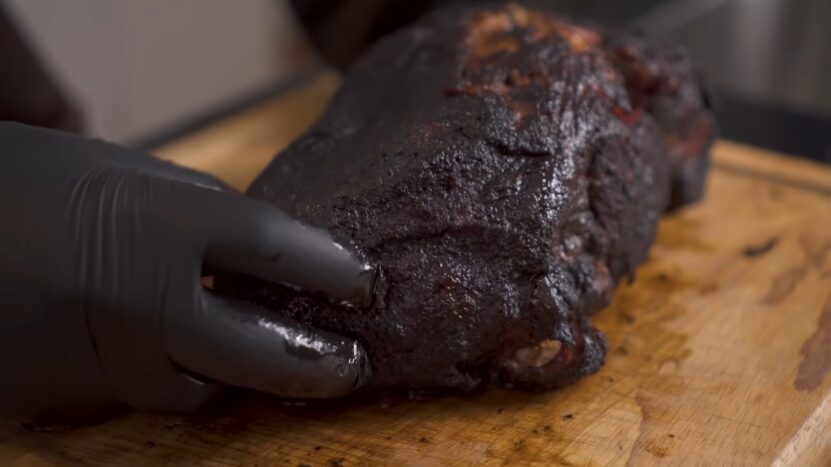If you’re on the quest for the perfect smoked pork butt or shoulder, you’ve probably mulled over the best type of wood to use. The wood you choose plays a pivotal role in the flavor profile of your meat.
With a myriad of options available, selecting the right wood can be both exciting and a tad overwhelming. But fear not, by the end of this article, you’ll have a thorough understanding of the best woods for smoking butt/shoulder and how they influence the final taste.
Wood Influences the Flavor
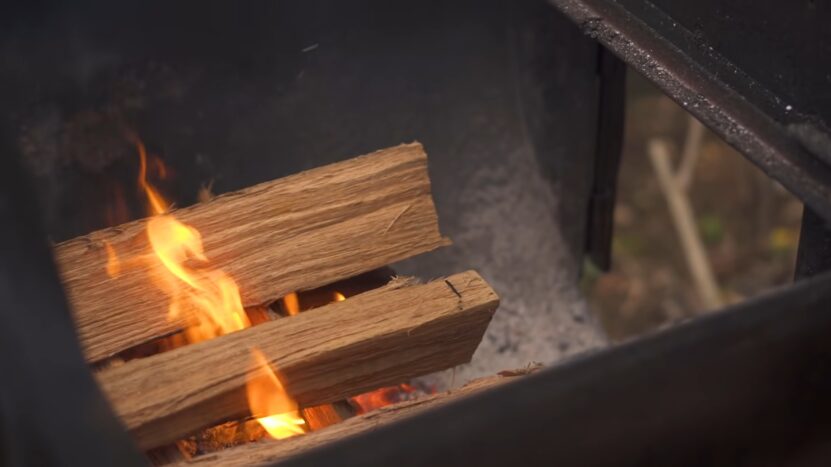
Every smoking enthusiast knows the significance of wood in the process. But what is it about wood that’s so influential?
Flavor Profiles and Woods
Each type of wood imparts its own unique flavor to the meat. Some woods offer a mild, fruity note, while others deliver a robust, smoky punch. It’s this intricate dance of flavors that can elevate your pork butt from merely good to absolutely sublime.
For butt/shoulder, which has a naturally rich flavor, the right wood can enhance its depth and create layers of taste that make every bite a culinary journey.
Combustion and Heat Consistency
Beyond flavor, the wood’s combustion rate and heat consistency play a vital role in the smoking process. Some woods burn hotter and faster, while others offer a slow, consistent burn ideal for the long smoking times required for pork butt.
It’s crucial to select a wood that not only complements the meat’s flavor but also provides the ideal heat for cooking. Balancing flavor and combustion is the key to smoking mastery.
Top Choices for Smoking Pork Butt
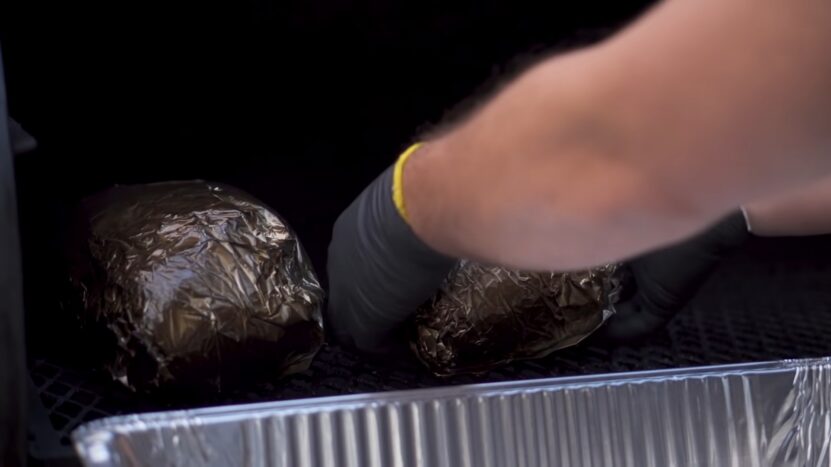
When smoking pork butt, some woods naturally stand out due to their flavor profiles and combustion characteristics. Let’s explore the top contenders.
Applewood: The Sweet Subtlety
Applewood delivers a mild, sweet, and fruity flavor, making it a favorite for pork. Its subtle undertones enhance the pork’s natural taste without overshadowing it. Applewood burns at a moderate rate, ensuring consistent temperatures throughout the smoking process. When looking for a gentle touch of sweetness to complement your pork butt, applewood is an excellent choice.
Hickory: The Robust Classic
Often dubbed the ‘King of Smoking Woods,’ hickory imparts a strong, bacon-like flavor to the meat. Its robust profile pairs wonderfully with the rich flavors of pork butt, making it a classic choice among BBQ enthusiasts.
However, hickory burns hotter than applewood. It’s essential to monitor the temperature closely to ensure even cooking. For those seeking a bold, smoky flavor, hickory is hard to beat.
Complementary Woods to Consider
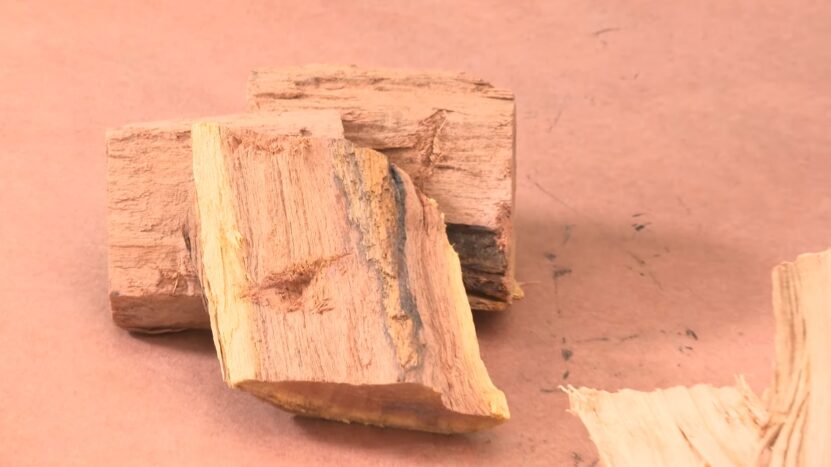
While applewood and hickory are go-to options, diversifying your wood selection can lead to exciting flavor combinations. Here are some additional woods to consider.
Cherrywood: The Fruity Finish
Cherrywood offers a sweet, fruity aroma with a hint of tartness. Its mild flavor profile makes it an excellent complement to pork, enhancing the meat’s natural taste. What’s more, cherrywood imparts a beautiful reddish-brown hue to the meat, making it not just delicious but also visually appealing.
If you’re aiming for a combination of taste and aesthetics, cherrywood is a worthy choice.
Mesquite: The Intense Smokiness
Mesquite wood is known for its intense, earthy flavor. While it’s a favorite for meats like beef, its strong profile can also work well with pork butt if used sparingly. Due to its intense flavor, it’s often mixed with milder woods like apple or cherry to balance the taste.
Mesquite burns hot and fast, so it’s crucial to keep an eye on the temperature during the smoking process. For those willing to experiment and play with bold flavors, mesquite offers a unique twist.
Blending Woods for Customized Flavors
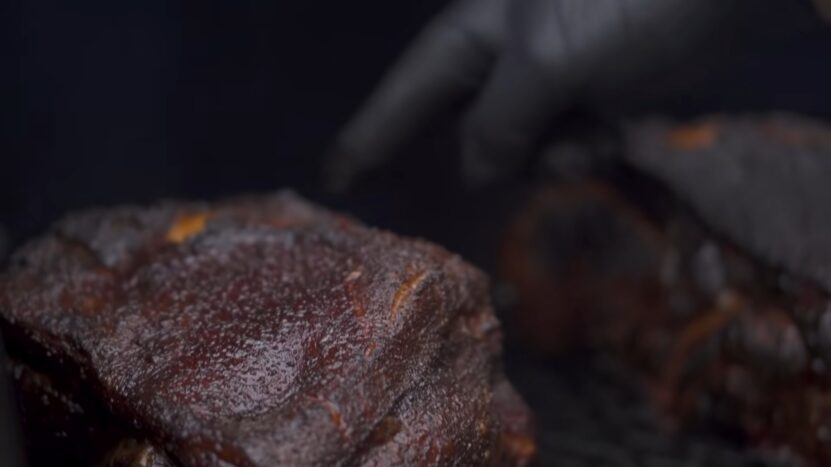
While using a single wood type has its merits, blending different woods can lead to delightful and unique flavor combinations, enhancing the overall smoking experience.
Applewood and Hickory: A Sweet and Smoky Fusion
Pairing applewood’s subtle sweetness with hickory’s robust smokiness creates a balanced and layered flavor profile for your pork butt. This blend ensures the meat isn’t overwhelmingly smoky, but it has enough depth to intrigue the palate.
When blending, a good rule of thumb is to use two parts applewood to one part hickory. This ratio keeps the hickory’s strong flavor in check, allowing the applewood’s sweetness to shine through.
Cherrywood and Mesquite: Bold and Fruity
This might sound like an unusual combination, but the fruity undertones of cherrywood can counteract the intense earthiness of mesquite. The result? A pork butt that’s rich in flavor with a surprising hint of fruitiness.
It’s advisable to use more cherrywood than mesquite in the blend—perhaps a three-to-one ratio. This ensures the mesquite doesn’t dominate the flavor profile, and the cherrywood adds its signature sweetness.
The Importance of Seasoned Wood
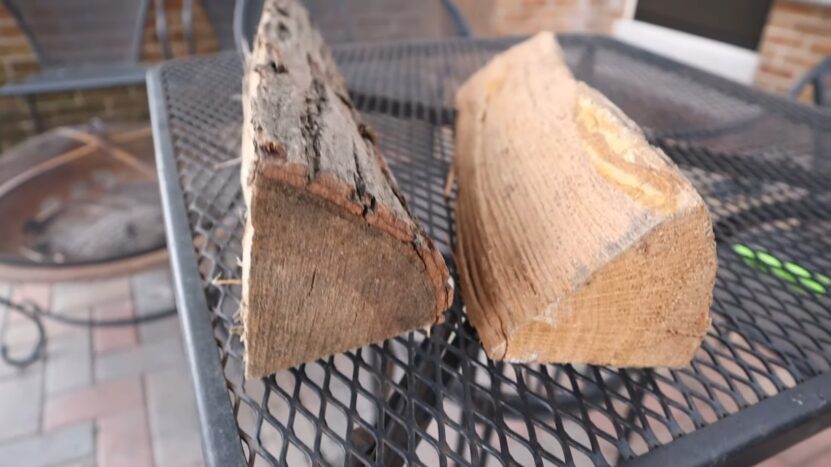
You’ve chosen your wood, but before you start smoking, there’s another crucial factor to consider: the wood’s seasoning.
Why Use Seasoned Wood?
Seasoned wood has been dried to reduce its moisture content. This makes it burn more consistently and efficiently. Fresh or “green” wood has high moisture content, leading to excessive smoke, which can produce a bitter taste on the meat.
For the best smoking experience, always opt for well-seasoned wood. Not only will it burn better, but it also imparts a cleaner, more flavorful smoke to your pork butt.
Storing and Seasoning Your Wood
If you’re seasoning your own wood, cut it into chunks and store it in a dry, well-ventilated area for at least six months. Ensure the wood is off the ground and covered to protect it from rain.
For those buying pre-seasoned wood, store it in a cool, dry place, and use it within a year to ensure it retains its optimal burning characteristics and flavor.
Expert Tips for the Perfect Smoke
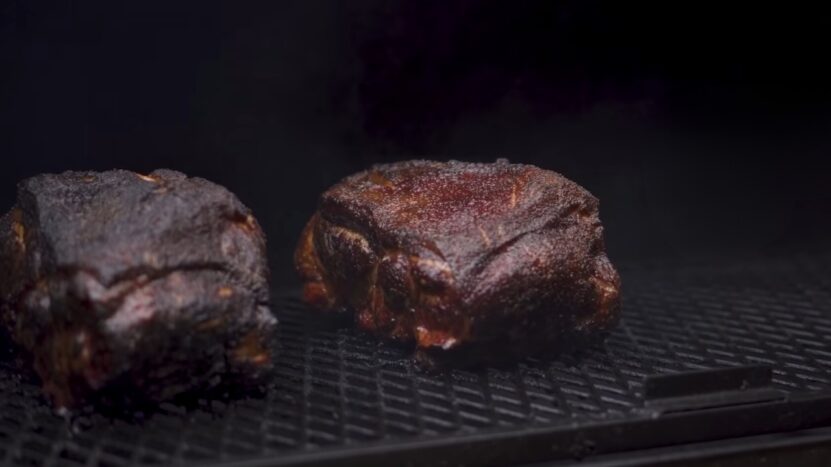
Now that you’re equipped with knowledge about woods and their flavors, here are some expert tips to elevate your pork butt smoking experience.
Maintaining Consistent Temperature
A consistent temperature ensures even cooking and optimal flavor infusion. Regularly check your smoker’s temperature and adjust vents or add coals as needed. For pork butt, maintaining a temperature between 225°F and 250°F is ideal.
Monitoring Smoke Color
Aim for thin, blue smoke. Thick white smoke can result in bitter flavors. If you notice heavy white smoke, check the airflow and ensure you’re using well-seasoned wood. Remember, it’s not about how much smoke you produce, but the quality of the smoke that impacts the flavor.
Common Mistakes and How to Avoid Them
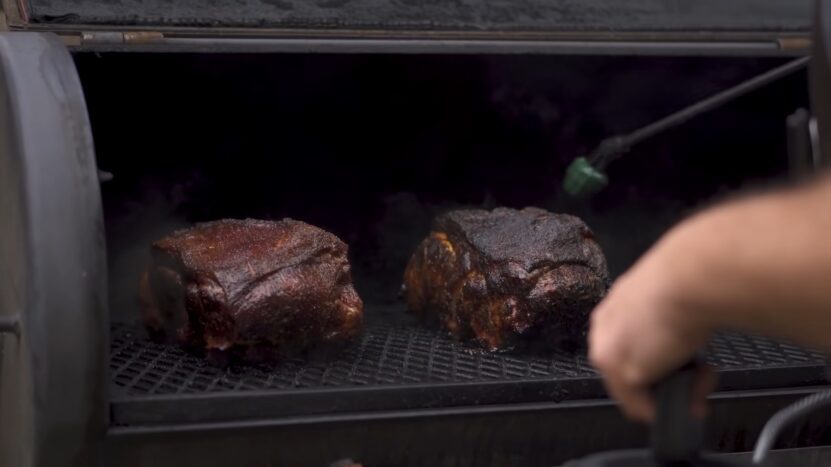
Even seasoned BBQ enthusiasts can sometimes run into pitfalls. Here’s a look at some common mistakes and how you can sidestep them for an impeccable smoking session.
Over-Smoking the Meat
It might sound counterintuitive, but there is such a thing as too much smoke. Continuously adding wood can overwhelm the pork’s flavor, resulting in a bitter taste.
To avoid this, once your pork butt has a good bark or crust formed on the exterior (usually after the first few hours), you can reduce or even stop adding wood.
The meat won’t absorb much more smoke after this point, and you can continue cooking with just the heat from the charcoal.
Impatience with Temperature Fluctuations
Temperature control is vital in smoking. However, constantly opening the smoker or grill to check the meat can lead to significant heat loss. This not only prolongs the cooking time but can also lead to unevenly smoked pork. Invest in a good-quality meat thermometer with a remote probe.
It allows you to monitor the internal temperature of the meat without frequently opening the smoker.
Pairing Recommendations
The flavors imparted by the wood during smoking can be further accentuated or balanced with the right sides and beverages. Here’s how you can take your meal to the next level.
- Sides for Smoked Pork Butt
- Coleslaw: The tanginess and crunch of a classic coleslaw can cut through the rich smokiness of the pork, offering a refreshing contrast.
- Grilled vegetables: Grilled corn or asparagus with a touch of butter and seasoning can complement the deep flavors of smoked pork.
- Beverage Pairings
- Craft Beers: A hoppy IPA or a malty amber ale can complement the flavors of the smoked pork, making each bite even more delightful.
- Red Wine: A medium-bodied red wine, like a Zinfandel, can offer fruity notes that pair wonderfully with the smokiness.
FAQs
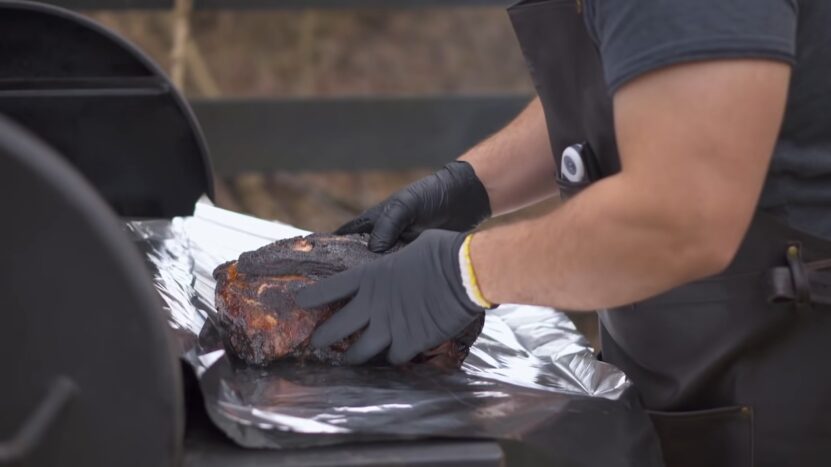
Can I Mix Different Woods Together?
Absolutely! Blending woods can create unique and complex flavor profiles. Popular combinations for pork butt include applewood with hickory or cherrywood with mesquite. However, it’s essential to balance the proportions to ensure one wood doesn’t overpower the other.
How Can I Tell if My Wood Is Seasoned?
Seasoned wood is dried and has a reduced moisture content. It’ll typically have a darker color, lighter weight, and might have cracks on the ends. It also produces a clear ringing sound when knocked together.
Fresh or “green” wood, on the other hand, feels heavier due to its moisture content and often has a sappy appearance.
Is There Such a Thing as Over-Smoking the Meat?
Yes, continuously adding wood and producing too much smoke can lead to a bitter taste in the meat. It’s essential to strike a balance to achieve a rich smoky flavor without overwhelming the pork’s natural taste.
Do I Always Need to Use Wood when Smoking Pork Butt?
Wood is primarily used for flavoring. If you’re looking for the smoky taste it imparts, then yes, you’d want to use wood. However, you can smoke pork butt using just charcoal or other heat sources, but it won’t have the same depth of flavor that wood provides.
How Can I Store Leftover Wood?
Store your leftover wood in a cool, dry place away from direct sunlight. If you’re using wood chunks or chips, consider keeping them in an airtight container to preserve their freshness and flavor.
Epilogue
The ideal wood for smoking pork butt/shoulder depends on the desired flavor profile. While woods like hickory and oak provide a robust and traditional smoke flavor, apple and cherry woods offer a sweeter and milder touch.
Experimenting with a mix of these woods can also yield unique and delectable results. Choosing the right wood can significantly elevate the taste and aroma of smoked pork butt/shoulder, making the culinary experience unforgettable.
